London was founded in the first century A.D. by the Romans who gave it the name “Londinium”. Subsequently London grew into a large trading center and important port on the river Thames, but it did not become the English capital until the twelfth century (the first capital of united England after the Heptarchy was Winchester in Hampshire).
After the settlement of southern Britain by Angles, Saxons and Jutes, London came to be part of the kingdom of Essex in southeastern England. According to early Orthodox tradition, Christianity was brought to London by the Holy Apostles Peter and Paul who both preached there. The tradition holds that St. Peter founded a church “in the west” which was a predecessor of what is now Westminster Abbey, while St. Paul erected a church “in the east”, which was a predecessor of what is now St. Paul’s Cathedral on Ludgate Hill. However, it is not known for certain where exactly the first Christian settlement and Christian Cathedral were located in present-day London. In recent times academics have suggested two sites apart from Ludgate Hill: the site of St. Peter’s Church on Cornhill as well as Tower Hill.
The first bishop of London whose name survived to this day was a Bishop Thean who lived in the second century, but nothing is known about him. Then there was a rather legendary bishop-martyr St. Augulus, who served either as bishop of London or else in Normandy (various sources do not agree on him). In 314, we also know that three bishops along with a priest and a deacon from Britain took part at a Church Council at Arles in Gaul. The British bishops were Restitutus of London (Londinium), Eborius of York (Eboracum) and Adelfius of either Lincoln or Colchester. The ecclesiastical history of Roman London after that Council is obscure.
After the Roman mission of St. Augustine of Canterbury to England, the first Anglo-Saxon bishop to be installed in London and the kingdom of Essex was St. Mellitus: he served as bishop of London from 604 till 617 and afterwards became the third archbishop of Canterbury. Next we find the holy hierarch Cedd who was a missionary in Mercia (central England) and especially in Essex. He served as bishop of London, most probably between 653 and 664. Of the early Orthodox bishops who served in London we can also mention St. Dunstan, who briefly held this post in 959 before being promoted to the see of Canterbury. But the greatest saint and heavenly patron of London is, beyond all doubt, St. Erconwald (also Earconwald), who was bishop of London between 675 and 693 and who has been venerated from ancient times as “the Light of London”. Let us recall his life.
The future saint was born in around 630 to a noble family and was related to the royal house. The young Erconwald was very rich but he promised to dedicate his life to the service of the Lord, so he used his wealth to found two monastic communities in c. 661: the first of them, a monastery for men, was situated in Chertsey in Surrey to the west of London where Erconwald became the first abbot, while the second, a convent, was built in Barking in Essex (now in Greater London) whose first abbess was Erconwald’s sister, St. Ethelburgh. St. Erconwald was famous for his holy life even before his consecration as a bishop. The saintly Greek Archbishop of Canterbury Theodore, a great uniting figure in seventh-century England, who consolidated the English people and Church, noted the holiness of Erconwald. He appointed him bishop of the East Saxons in succession to the simoniac bishop Wine. The year of his consecration was 675, though some sources claim 672. His large diocese comprised the present-day county of Essex and Greater London with parts of Surrey and Hertfordshire.
The principal source for the life of St. Erconwald is the Venerable Bede, who wrote about him and admired him early in the eighth century in his History of the English Church and People. During his episcopacy Erconwald made many missionary and peace-making journeys across his diocese, increasing his flock in London immensely. Notably, he considerably enlarged St. Paul’s Cathedral in London, secured special privileges for it, and about the year 686 reconciled two great archpastors: Theodore of Canterbury and Wilfrid of York. In the preamble to the Code of Laws of the holy king Ina (Ine) of the West Saxons St. Erconwald is referred to as “my bishop”, and as one of the contributors and advisers. In fact, the saint was reputedly responsible for developing the charters of some Anglo-Saxon kings. It is believed that it was St. Erconwald who converted the righteous and holy king Sebbi (Sebba) of Essex to Christ. We presume that it was not without the influence of St. Erconwald that the life and thirty-year reign of this king were marked by prayer, fasting, mercy and almsgiving; and shortly before his death Sebbi became a monk.
It was said that his holy sister, St. Ethelburgh, noted for her ascetic life, care, and wisdom, from time to time accompanied St. Erconwald on his missionary trips. In the final years of his life St. Erconwald suffered much from gout, but despite the illness he remained an energetic archpastor; he was carried on a special wheeled litter on his journeys and performed many miracles. St. Erconwald reposed in the Lord on April 30 (according to the old calendar), 693, in Barking, where he had retired shortly before his repose to live as a simple monk, venerated by all. He was buried in the old St. Paul’s Cathedral and was at once proclaimed a saint.
Though Chertsey, London and Barking all claimed his relics, the saint’s main relics always remained in London, with probably some minor relics distributed to both of his the monasteries he founded. This is what St. Bede says of the veneration of St. Erconwald after his death: “This Erconwald's life and conversation, as well when he was bishop as before his advancement to that dignity is reported to have been most holy, as is even at this time testified by heavenly miracles; for to this day his horse litter, in which he was wont to be carried when sick, is kept by his disciples, and continues to cure many of agues and other distempers; and not only sick persons who are laid in that litter, or close by it, are cured; but the very chips of it, when carried to the sick, are wont immediately to restore them to health” (Bede, the Ecclesiastical History of the English Nation, Book IV, Chapter VI, the English translation by L.C. Jane, 1903).
In the Middle Ages St. Erconwald was the major saint of London and was called “the Light of London” by the pious faithful. The relics of St. Erconwald remained absolutely undamaged (including the silk coverings on his shrine) in the fire that occurred at the St. Paul’s Cathedral in 1087. Afterwards they were placed in the Cathedral crypt. In November 1148 the relics were solemnly translated again and placed in the shrine behind the high altar. In 1326 a new translation followed—to another shrine that was enriched by the cathedral clergy and by the guilds of merchants throughout the late Middle Ages.
There are several notable pieces of medieval literature and poetry about St. Erconwald, the most remarkable of which is “St. Erconwald”—a famous poem written in the fourteenth century. It recounts how England first was a pagan land but then enlightened by the light of Christ through Sts. Augustine, Erconwald and other saints. Then it says that during a rebuilding of St. Paul’s Cathedral a splendid tomb was discovered and the well-preserved body of a noble man was found inside it. When Erconwald came up to the tomb the corpse began to speak—the man said that he had lived before Christ and was a very fair and just judge in his lifetime, but as he did not live until Christ he was being tormented in hell. Touched by his story, Erconwald baptized him with his own tears and the man, acknowledging that he had achieved eternal bliss, turned to dust.
The feast-days of St. Erconwald (the date of his repose and dates of translations of his relics) were listed among the major Church festivals in London’s Cathedral. Miracles at the shrine of St. Erconwald continued until the Reformation during the reign of Henry VIII, when the shrine of St. Erconwald was robbed and desecrated, while his relics were either destroyed or hidden in a secure place by the faithful from the bloodthirsty iconoclasts. There is a modern speculation that the relics of St. Erconwald may still rest at the east end of the present Cathedral choir next to the east altar. Perhaps one day the Lord will reveal the fate of this holy man’s bodily remains.
St. Erconwald is venerated by Orthodox and Catholics to this day, especially as a patron-saint of London, and his name is invoked against gout. A number of modern Catholic parish churches are dedicated to St. Erconwald, among them are churches in Wembley (north-west London), Walton-on-Thames (Surrey), Ingatestone (Essex; another patron of the parish is St. John the Baptist).
Let us now talk of the holy sites associated with St. Erconwald. The Chertsey monastery that he founded prospered until the ninth century when it was ravaged by the pagan Danes who killed the Abbot Beocca, Hieromonk Ethor and some ninety monks in about 870. These have been officially venerated as the Holy Martyrs of Chertsey since then. In the tenth century, through the efforts of the holy King Edgar of England, the monastery was restored, and it existed until the Reformation when it was closed in 1537. Now only minor ruins of this abbey survive. The parish church in the town of Chertsey is dedicated to St. Peter, like the ancient monastery. Some fine examples of the tiles from this abbey are kept at the British Museum.
The Barking Convent founded by Erconwald produced many saints and grew into one of the richest and most prosperous and influential convents in medieval England. Its first abbess, St. Ethelburgh, reposed in c. 675 and was succeeded by the highly educated holy abbess Hildelith who ruled over Barking for some 37 years. St. Bede recounted life in Barking and the miracles that occurred there; for example, the healing of a poorly-sighted woman, and how many saw a supernatural light in the convent. Some miracles were connected with the holy nun Thorgyth who bore her paralysis with great patience. In the late seventh century there lived in Barking a holy nun called Cuthburgh, who later founded the great convent in Wimborne in Dorset. In the tenth century, at the time of the monastic revival in England, Barking had another saintly abbess named Wulfhild.
For 900 years Barking was one of the best-known holy sites near London. Today there remains only one church, St. Margaret’s, and a former gatehouse called the curfew tower. The church dates from the thirteenth century and was built by the convent for the townsfolk. It survived the Reformation and is still used as a parish church; in 1762 the explorer James Cook was married there. The church is richly decorated inside in various styles. The main surviving relic of Barking is the early cross (kept in the chapel on the top of the tower). In the Middle Ages this carved stone crucifix attracted countless pilgrims. The Mother of God and St. John the Theologian are depicted on either side of the crucified Savior. Stone crucifixes were rare in England; most were wooden. The main convent church stood nearby. Parts of its foundations still survive; it was some 100 meters (c. 328 feet) long.
By 1541 this once huge abbey lay in ruins, a victim of the Reformation. The abbey was dedicated to Sts. Mary and Ethelburgh. Throughout its history several queens and kings’ daughters were among its abbesses. A few parish churches were dedicated to St. Ethelburgh of Barking, the most famous of them being St. Ethelburgh’s Church in Bishopsgate in London. It stood for many centuries, surviving both the Great Fire of 1666 and the German bombings in the Second World War; but, alas, this wonderful church was destroyed by a bomb of the Irish Republican Army set off in Bishopsgate in April 1993. Though the building was then rebuilt, it is not used as a church any more.
St. Paul’s Cathedral has been one of the symbols of Britain’s capital. The present structure was built by the celebrated architect Christopher Wren (1632-1723) between 1675 and 1710. Although there are no shrines of saints at the Cathedral any more, the saints who are closely associated with the historical Cathedral are commemorated here either in icons or monuments. Moreover, there are chapels at the cathedral dedicated to St. Dunstan (used for quiet private prayer) and St. Erconwald.
Many prominent figures are buried or commemorated at the Cathedral, especially in the crypt. These include the architect Christopher Wren (a well-known inscription on his tomb reads: “Reader, if you seek a monument, look around you,” because the present building is his masterpiece); Admiral Horatio Nelson (1758-1805); the First Duke of Wellington (1769-1852—it was he who defeated Napoleon at the Battle of Waterloo and later became Prime Minister); the poet and artist William Blake (1757-1827—he introduced romanticism into English poetry); the preacher, poet and clergyman John Donne (1572-1631, dean of St. Paul’s from 1621—to him belongs the famous saying: “Ask not for whom the bell tolls, it tolls for thee”); the great painter William Turner (1775-1851); the composers Hubert Parry (1848-1918) and Arthur Sullivan (1842-1900); the famous nurse Florence Nightingale (1820-1910), and Alexander Fleming (1881-1955—a bacteriologist who first discovered the effect of penicillin on bacteria).
The current dome of the Cathedral is one of the highest and finest in the world. It was modelled on St. Peter’s Basilica in the Vatican. The Cathedral together with its dome is now 111 meters (c.364 feet) high and until the 1960s it was the highest construction in London. The total length of the church is 158 meters (c. 518 feet). It is the second largest church structure in modern Britain after Liverpool Cathedral. The west front has a bas-relief depicting the conversion of St. Paul crowned by the statues of Sts. Peter, Paul and James. The twin towers of this front house bells and the clock, including the largest and most famous bell, Great Paul, which weighs c.16.5 tons (it was the largest bell in England until 2012 when the Olympic Bell weighing 22.9 tons was cast). A statue of Queen Anne stands in front of the cathedral—she was the ruling monarch when this church was built. The Cathedral is cruciform, very broad and has a special atmosphere of holiness, strength and splendor inside. The sense of spaciousness is clearly felt in the nave, north and south transepts and north and south aisles. There are many mosaics, sculptures and stained glass in the Cathedral.
In the central dome there is the “whispering gallery” which is very popular with tourists. (These galleries have such acoustic properties that any faint sound may be heard around its entire circumference). The frescoes inside the dome depicting the life of St. Paul were heroically created by the great painter James Thornhill (1575-1634). There are many other treasures within the Cathedral, including the elegant choir stalls, the Lady Chapel, the chapel dedicated to all the Protestant martyrs and so on. The Cathedral crypt, the largest in Europe, is unique, as it is located beneath the whole building. It is very gracious and contains many treasures and memorials, along with the chapel of the order of the British Empire.
St. Mellitus organized the building of the wooden cathedral of St. Paul on this site in about 604. That was destroyed by fire in the tenth century and rebuilt before the Norman Conquest. The building of the first Norman cathedral of St. Paul began in 1087, which developed into a huge Romanesque and Gothic piece of architecture by 1240. This cathedral stood until Christopher Wren, and was the largest church building in the British Isles, the third largest in Europe and had the tallest spire in England. The church was enlarged in the late medieval era but started to decay after the Reformation. The Great Fire of London in 1666 put an end to the splendid edifice, and Wren rebuilt it in the English baroque style.
The Cathedral was built using the royal quarries of the Isle of Portland in Dorset (in fact a great number of London’s famous buildings were built of this high-quality limestone). By a miracle of God the Cathedral was not damaged during the German bombing in the Second World War at all. Recently the Cathedral has undergone some restoration work and it now has an appearance very similar to that of the time of Wren when he built it 300 years ago.
Holy Hierarch Erconwald, pray to God for us!

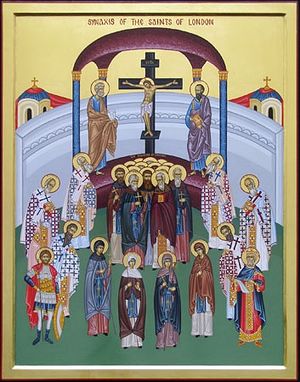
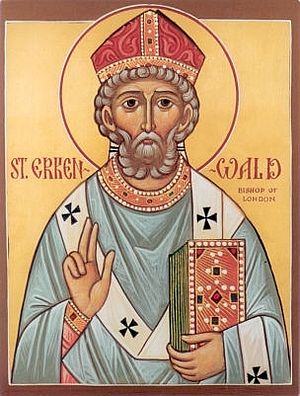
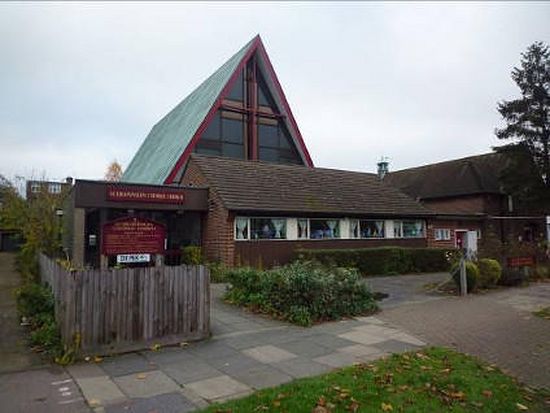
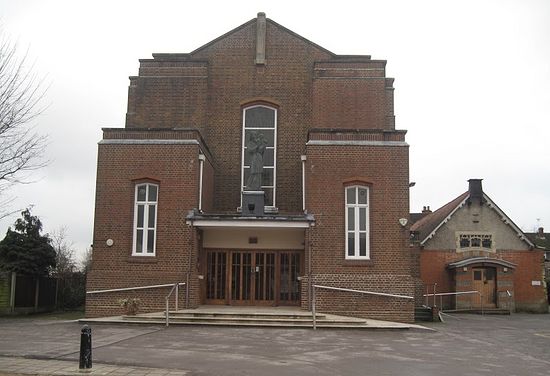
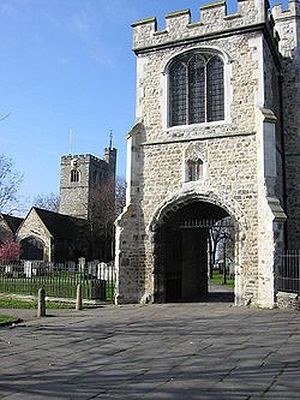
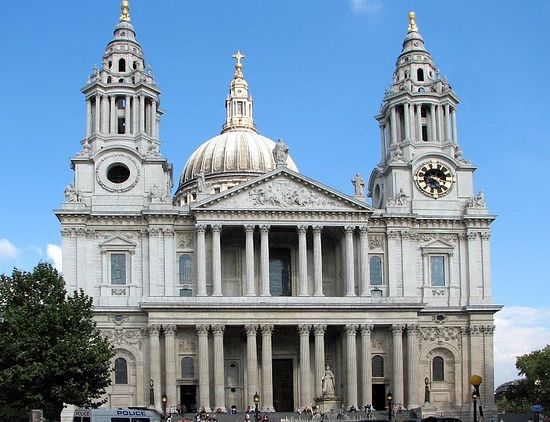
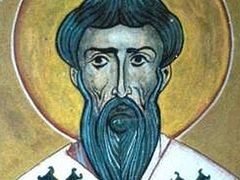
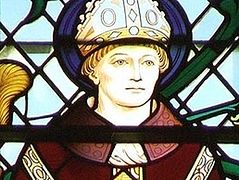
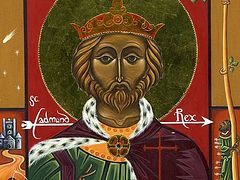
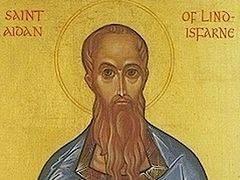
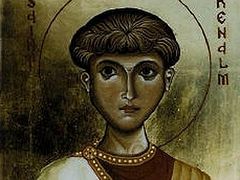
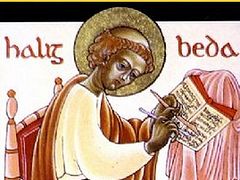
Thank you for this informative article.
You mention St Ethelbugh's Church in Bishopsgate, in the City of London. While this bjildiong was, indeed, severely damaged by an IRA bomb in 1993 and subsequently rebuilt, it is not quite true to say that it is no longer used as a church.
In fact a Moldovan language parish on the Diocese of Sourozh use the church each Sunday for the Divine Liturgy.
Yours in Christ,
Archpriest Raphael Armour,
Rector, Russian Orthodox Parish of St Ephraim the Syrian, Cambridge.
Diocese of Sourozh,
Moscow Patriarchate
In the tenth century the famous Byzantine Orthodox hagiologist St. Simeon Metaphrastes related that the Holy Apostle Peter made a missionary journey across the countries of the East, then arrived to Rome and after that proceeded to the west: Spain, North Africa, Gaul and Britain. St. Simeon writes that St. Peter spent much time in Britain and converted many of its inhabitants to Christ, consecrated bishops, ordained priests and deacons. In Britain an angel appeared to St. Peter and told him to return to Rome and to be martyred for Christ.
As well, according to historian Alan Wilson, the Welsh language is very similar to Hebrew and culturally the Welsh come from Syria--Christianity arrived in Wales in 37 AD with one of the Welsh Kings.